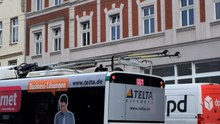Ironing
The term ironing is commonly used on trams , railways and trolleybuses and describes the application of a pantograph to the overhead line . The term refers to the pantograph .
Depending on the vehicle type and age, ironing is carried out in different ways:
- In classic tram cars, the pantographs are permanently pressed against the contact wire by one or more springs and pulled off with a line. For ironing, this is only released in the driver's cab. With lyre or pantographs, the lines are usually outside the car body, the driver has to leave the vehicle to iron it up and down.
- In newer wagons without compressed air equipment, the pantographs are moved with electric motors, springs in between push the pantograph against the contact wire and equalize height differences.
- In long-distance rail vehicles, the pantographs are usually lifted by compressed air. The mass of the pantograph frame is partially balanced by springs, which reduces the compressed air requirement. The advantage of the compressed air drive is that the failure of the compressed air supply automatically lowers the pantograph in the event of a malfunction.
To disconnect the power connection, different variants are possible depending on the vehicle type and age. Removing the bracket from the overhead line is called ironing .
